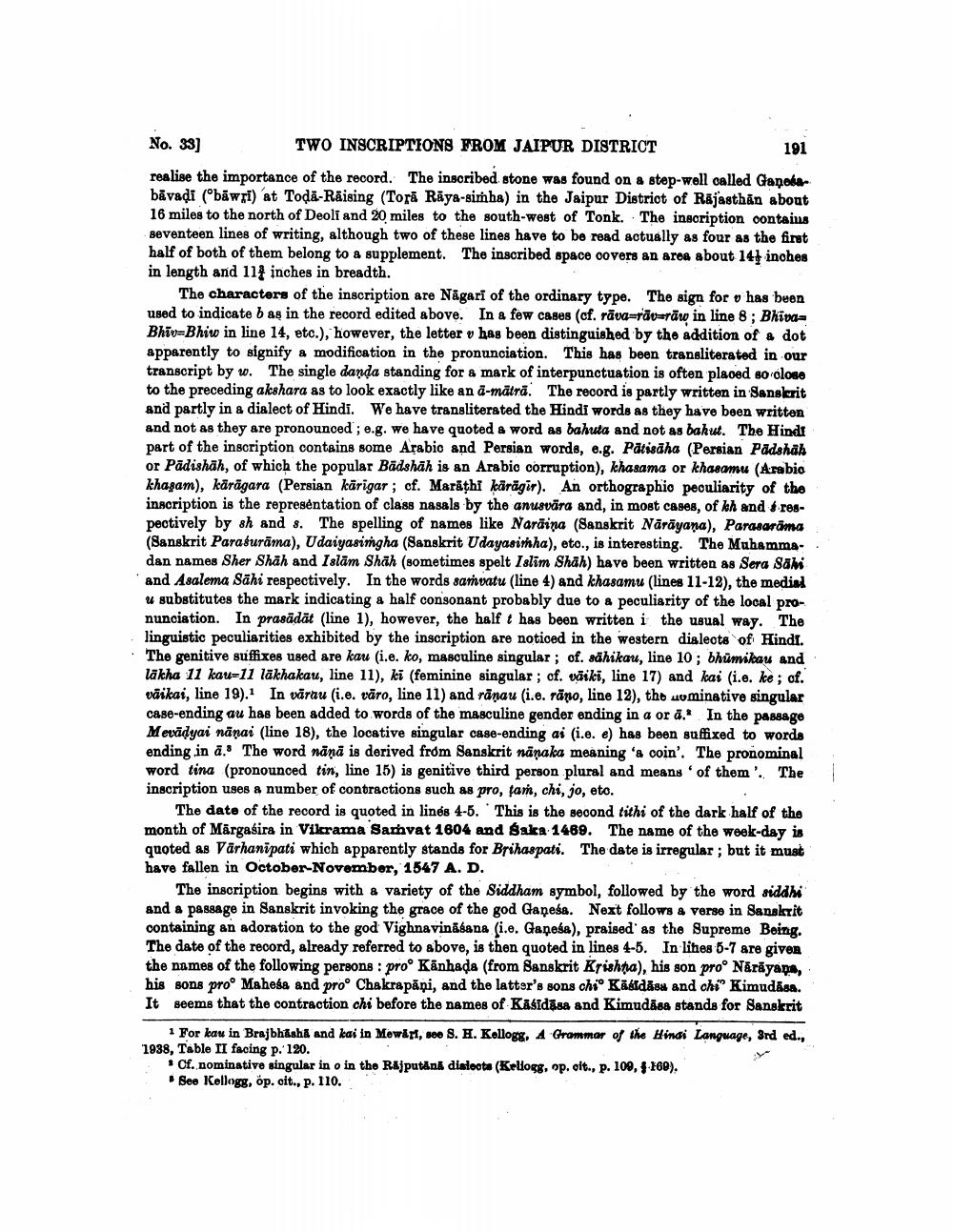________________
No. 33) TWO INSCRIPTIONS FROM JAIPUR DISTRICT
191 realise the importance of the record. The inscribed stone was found on a step-well called Ganoda bāvadi (obāwri) at Toda-Räising (Torā Rāya-simba) in the Jaipur District of Rajasthan about 16 miles to the north of Deoli and 20 miles to the south-west of Tonk. The inscription contains seventeen lines of writing, although two of these lines have to be read actually as four as the first half of both of them belong to a supplement. The inscribed space covers an area about 144 inches in length and 114 inches in breadth.
The characters of the inscription are Nägari of the ordinary type. The sign for v has been used to indicate b as in the record edited above. In a few cases (cf. rāvgarduräre in line 8: Bhivaa Bhīv=Bhiw in line 14, etc.), however, the letter v has been distinguished by the addition of & dot apparently to signify a modification in the pronunciation. This has been transliterated in our transcript by w. The single danda standing for & mark of interpunctuation is often placed so close to the preceding akshara as to look exactly like an ā-mātrā. The record is partly written in Sanslerit and partly in a dialect of Hindi. We have transliterated the Hindi words as they have been written and not as they are pronounced'; e.g. we have quoted a word as bahuta and not as bahut. The Hindi part of the inscription contains some Arabic and Persian worde, e.g. Patisäha (Persian Padshah or Padishah, of which the popular Badshah is an Arabic corruption), khasama or khasamu (Arabio khagam), kärägara (Persian karigar; cf. Marathi kārāgir). An orthographio peculiarity of the inscription is the representation of class nasals by the anusvära and, in most cases, of kh and respectively by sh and 8. The spelling of names like Nardina (Sanskrit Närāyana), Parasarāma (Sanskrit Parafurāma), Udaiyasingha (Sanskrit Udayasinha), eto., is interesting. The Muhammadan names Sher Shah and Islām Shah (sometimes spelt Islim Shah) have been written as Sera Sali and Asalema Sähi respectively. In the words sarvatu (line 4) and khasamu (lines 11-12), the medial u substitutes the mark indicating a half consonant probably due to a peculiarity of the local pronunciation. In prasādāt (line 1), however, the half t has been written i the usual way. The linguistic peculiarities exhibited by the inscription are notioed in the western disleots of Hindi. The genitive suffixes used are kau (i.e. ko, masculine singular ; of. sähikau, line 10; bhumikau and lakha 11 kau-11 läkhakau, line 11), ki (feminine singular; of. väiki, line 17) and kai (i.e. ke; of. vaikai, line 19). In vārau (i.e. väro, line 11) and rānau (i.e. ráno, line 12), the uominative singular Case-ending au has been added to words of the masculine gender ending in a or a." In the passage Mevādyai nänai (line 18), the locative singular case-ending ai (i.e. e) has been suffixed to words ending in a. The word nāņā is derived from Sanskrit nänaka meaning '& coin'. The pronominal word tina (pronounced tin, line 15) is genitive third person plural and means of them. The inscription uses a number of contractions such as pro, fanh, chi, jo, eto.
The date of the record is quoted in lines 4-5. This is the second tithi of the dark half of the month of Märgasira in Vikrama Samvat 1604 and Saka 1469. The name of the week-day is quoted as Varhanipati which apparently stands for Brihaspati. The date is irregular; but it must have fallen in October-November, 1847 A. D.
The inscription begins with a variety of the Siddham symbol, followed by the word siddhi and a passage in Sanskrit invoking the grace of the god Ganesa. Next follows a verse in Sanskrit containing an adoration to the god Vighnavināšana (i.e. Ganesa), praised as the Supreme Being. The date of the record, already referred to above, is then quoted in lines 4-5. In lihes 6-7 are given the names of the following persons : proo Känhada (from Banskrit Krishna), his son proo Nārāyapa, his sons proo Mahesa and proo Chakrapani, and the latter's sons chio Kakdåss and chi” Kimudása. It seems that the contraction chi before the names of Kasidasa and Kimudāsa stands for Sanskrit
1 For kan in Brajbhiksha and kai in Mowart, so 8. H. Kellogg, A Grammar of the Hindi Language, 3rd ed., 1938, Table II facing p. 120.
Cf. nominative singular in o in the Rajputana dialecta (Kellogg, op.olt., p. 109, 160). See Kellogg, op. cit., p. 110.




